ABOUT
Research in the Biomaterials for Regenerative Therapies group is devoted to the development and knowledge transfer to industry of innovative biomaterials and scaffolds for tissue regeneration.
We design, fabricate and characterize bioactive and biodegradable materials and we investigate their interactions with biological entities, both in terms of their fundamental aspects and with specific applications for tissue engineering purposes in mind. The aim is the repair and functional restoration of tissues or organs by means of 3D scaffolds, cells, and signals.
Our research is built up in three pillars:
- Creating microenvironments for tissue regeneration. Understanding the interaction of the designed scaffolds with the cells is the key to induce a regenerative environment. We have developed models that explain the activation of angiogenesis and neurogenesis promotion based on the biomaterials properties and the structure of the scaffold, together with the degradation products that promote a bioactive environment. During 2018 we have studied the activation of progenitor cardiac cells, recruitment and differentiation in response to these scaffolds by means of instructive matrices.
- Translating basic research towards new developed products. We are applying Key Enabling Technologies in Biomaterials fabrication to give solutions to companies. A personalized maxillofacial substitute using 3D printing is being developed together with Avinent Implant system, SL. A new dressing that promotes the fast healing of chronic wounds, promoting cell recruitment and regeneration is now under preclinical studies.
- Disease models. We are developing 3D models for pre-clinical cancer research based on the use of cells self-produced extracellular matrices. These microtissues can be modified to culture cancer cells and simulate an ex vivo tumor that can be used for basic cancer research or drug screening. We are also developing novel bioinks for the fabrication of bioprinted platforms as 3D models and bioengineered constructs. The use of microfluidic devices that simulate a vessel, or a cardiac tissue is another approach we are modelling to study the cardiac regeneration process.
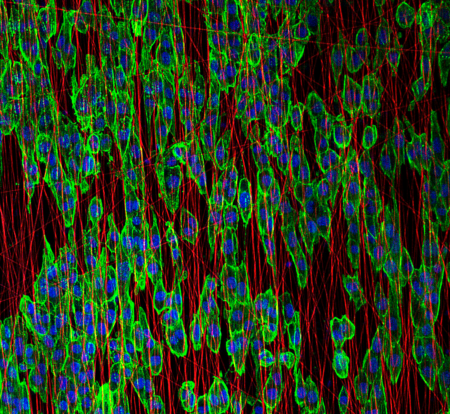
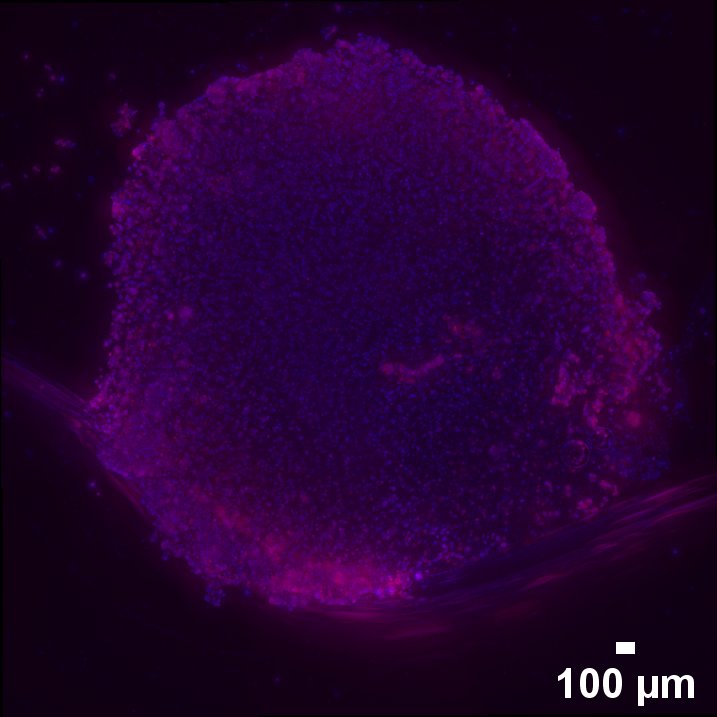
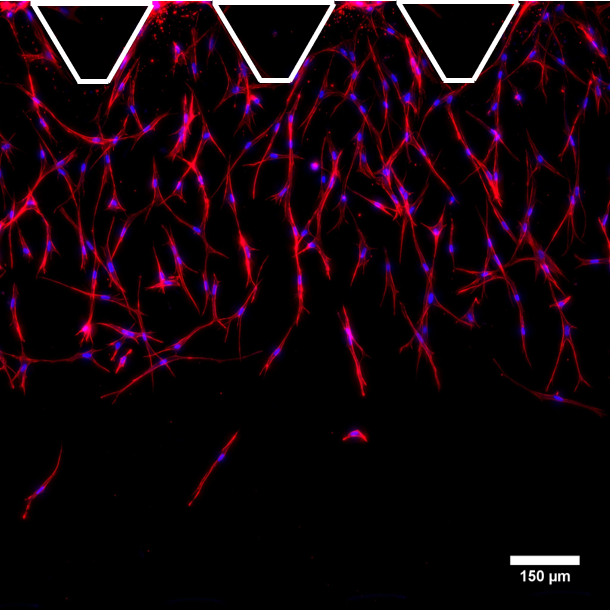
We are members of CIBER-BBN (Centro de Investigación Biomédica en Red – Bioingeniería, Biomateriales y Nanomedicina)
We are participants of the RIS3CAT LLAVOR 3D Community, funded by ACCIO, that aims to accelerate the development and adoption of additive manufacturing and 3D printing* technologies by the industry.*
We participate in two networks: i4kids, the Pediatric Innovation Hub, coordinated by SJD Barcelona Children’s Hospital, which aims to generate a positive social impact and offer solutions adapted to the paediatric population; and in the XaRFA, with 28 research groups from 14 Catalan entities, created with the aim of creating up to 12 technology-based companies and facilitating the transfer of 3D printing technologies to society.
We are members of a CIBER-ONC project: Patient Derived Organoids 2.O: Recapitulating stromal and immune microenvironment in annotated organoid platforms for advancing towards personalized cancer treatment.
We are new members of the Red de Terapia Celular (Tercel) to collaborate with the cell therapy groups in tissue and organ regeneration.
| *QuirofAM. Ecosistema d’R+D+i per la implementació i adopció de la Fabricació Additiva / Impressió 3D a la indústria de Salut (2018-2021). El proyecto QuirofAM está enmarcado dentro de la comunidad Llavor 3D, impulsada por la Generalitat de Catalunya para acelerar y desarrollar la adaptación de la fabricación aditiva en el sector industrial y cofinanciada mediante el programa operativo FEDER Catalunya 2014-2020. El objetivo del proyecto QuirofAM es la transformación de la práctica quirúrgica mediante la incorporación de la fabricación aditiva en tres niveles: modelos de ensayo quirúrgico, guías e implantes para reconstrucción e implantes bioactivos para la generación de tejidos. Uno de los beneficios más interesantes que tiene esta tecnología en el sector biomédico es la individualización de tratamientos. |
STAFF
Former Member
Prof. Josep Planell | Director, Universitat Oberta de Catalunya (UOC)
PROJECTS
| NATIONAL GRANTS | FINANCER | PI |
|---|---|---|
| DERMOGLASS · Desenvolupament d’un producte sanitari amb partícules inorgàniques pel tractament de ferides (2021 – 2023) | ACCIÓ, INNOTEC | Elisabeth Engel |
| DERMOGLASS · Fabricació i avaluació d’un prototip d’apòsit per a la cicatrització de ferides (2020-2022) | AGAUR · Ajuts Producte destinats a l’obtenció de prototipus i a la valorització i transferència dels resultats d’investigació generada per equips de recerca de Catalunya. | Elisabeth Engel |
| nAngioDerm · Materiales liberadores de iones para promover la angiogénesis en regeneración dérmica (2019-2022). | MINECO, Acciones de Programación Conjunta Internacional | Elisabeth Engel |
| BASE3D · Agrupació en tecnologies emergents en fabricació aditiva (2019 – 2022) | RIS3CAT · Tecnologies Emergents | Josep Samitier |
| BIOCARDIO · Bioingeniería de constructos basados en biomateriales para la regeneración cardiaca (2019-2021). | MICIU, Retos investigación: Proyectos I+D | Elisabeth Engel |
| TERCEL · Red de terapia celular (2018-2022). | MINECO – ISCIII, Redes temáticas de investigación cooperativa en salud | Elisabeth Engel |
| PRIVATELY FUNDED PROJECTS | FINANCER | PI |
|---|---|---|
| DERMOGLASS · Smart dressing for the treatment of chronic wounds (2019-2022). | Obra Social “la Caixa” · CaixaImpulse | Elisabeth Engel |
| FINISHED PROJECTS | FINANCER | PI |
|---|---|---|
| QuirofAM. Ecosistema d’R+D+i per la implementació i adopció de la Fabricació Additiva / Impressió 3D a la indústria de Salut (2018-2021). | ACCIO, Acreditació de comunitats RIS3CAT i la selecció de projectes col·laboratius de recerca, desenvolupament i innovació | Elisabeth Engel |
| NAngiofrac | Euronanomed | Elisabeth Engel |
| THE GRAIL · Tissue in Host Engineering Guided Regeneration of Arterial Intimal Layer (2012-2016). | HEALTH | Elisabeth Engel |
| DERMOGLASS · Smart dressing for the treatment of chronic wounds (2016-2017). | Obra Social La Caixa, Caixaimpulse, EIT Health | Xavier Puñet |
| Diseño y desarrollo de biomateriales bioactivos para la regeneración de la piel basada en la señalización controlada de liberación de iones (2013-2016). | I+D-Investigación fundamental no orientada | Elisabeth Engel |
| Andamios diseñados para promover una vascularización eficiente para fracturas óseas no consolidadas (2012-2016). | I+D-Investigación fundamental no orientada | Oscar Castaño |
| INSBIOMAT · Biomateriales instructivos para regeneración cardíaca in vivo (2015-2016). | MINECO, Acciones Dinamización “Europa Excelencia” | Elisabeth Engel |
| BIOTENDON · Tendon Tissue Engineering: A Helping Hand for Rotator Cuff Tears. | RECERCAIXA | Elisabeth Engel |
| Nous models de bioimpressió 3D d’os per a ús maxil·lofacial (2017-2019). | MINECO, Retos investigación: Proyectos I+D | Elisabeth Engel |
| MICARE · Creación de microentornos para la regeneración cardíaca in vivo (2017-2019). | MINECO, Acciones Dinamización Europa Investigación | Elisabeth Engel |
| MatriCell · Desarrollo de partículas poliméricas para generar matrices extracelulares in vitro (2016-2019). | MINECO, Retos investigación: Proyectos I+D | Elisabeth Engel |
| State of the Art Research on Expandable Materials (2017-2018). | TUCSE, S.L | Miguel Ángel Mateos |
PUBLICATIONS
EQUIPMENT
- Surface characterization equipment (contact angle, Z potential, nanoindenter)
- Cell culture facilities
- Molecular Biology equipment: protein and DNA electrophoresis
- Thermocycler (PCR)
- Rapid prototyping tool (part of the Production of biomaterials and nanoparticles platform of the CIBER-BBN)
http://www.ciber-bbn.es/programas/plataformas/equipamiento/biomateriales?nodo=nodo2&locale=en - Peptide synthetiser
- Combustion furnace
- Electrospinning device
- Spin-coater
- Vibrational viscosimeter
COLLABORATIONS
- Prof. Mario Barbosa
Instituto de Investigação e Inovação em Saúde da Universidade do Porto, Portugal - Dr. Riccardo Levato
UMC Utrecht, The Netherlands - Prof. Didier Letourneur
Laboratoire de Bioingénierie Cardiovasculaire, INSERM, University Denis Diderot-Paris 7, Paris, France - Prof. Dirk Grijpma
Department of Biomaterials Science and Technology, University of Twente, Twente, the Netherlands - Prof. Francesco Serino
Department of Vascular Surgery, Istituto Dermatologico dell’Immacolata (IDI), Rome, Italy - Dr. Jerónimo Blanco
Institut de Ciències Cardiovasculars de Catalunya and CSIC, Barcelona, Spain - Dr. Joelle Amedee
INSERM, University of Bordeaux Segolen, Bordeaux, France - Dr. José Becerra Ratia
Dept. Biología Celular, Genética y Fisiología, Universidad de Málaga, Spain - Dr. Margarita Calonge
Institute of Ophthalmobiology (IOBA), Universidad de Valladolid, Spain - Dr. José Carlos Rodríguez-Cabello
Dept. de Física de la Materia Condensada, Universidad de Valladolid, Spain - Prof. Kevin Healy
Biomaterials & Tissue Engineering Laboratory, University of California at Berkeley, USA - Prof. Wouter J.A. Dhert & Dr. Jos Malda
Department of Orthopaedics, University Medical Center Utrecht, The Netherlands - Prof. Andrés J. García, F.B.S.E.
Institute for Bioengineering and Bioscience, Georgia Institute of Technology, Atlanta, GA - Dr. Luigi Ambrosio
Institute of Polymers, Composites & Biomaterials, National Research Council, Naples, Italy - Prof. Carlos Semino
Grupo de Insuficiencia Cardíaca y Regeneración Cardíaca (ICREC), IQS School of Engineering, Universitat Ramon Llull - Dr. Antonio Sinovas
Vall d’Hebron Institute of Research - Dr. Dimitrios Zeugolis
Biomedical Engineering (Biomaterials) at NUI Galway - Dr. Aitor Aguirre
Department of Biomedical Engineering, MSU, Michigan, US - Prof. Joao Mano
CICECO, Aveiro University, Portugal - Prof. Gino Ambrosio
Università degli Studi di Napoli Federico II: Napoli, Campania, Italy - Prof. Timothy Thomson
IBMB-CSIC, Barcelona - Dr. Elena Rebollo
IBMB-CSIC, Barcelona - Dr. Jordi Camps
Gastrointestinal and Pancreatic Oncology Group, Institut D’Investigacions Biomèdiques August Pi i Sunyer (IDIBAPS) - Dr. Olivier Stephan
Univ-grenoble-alpes, France - Prof. Humberto Palza
Departamento de Ingeniería Química, Biotecnología y Materiales, Universidad de Chile - Dr. Judith Guasch
ICMAB, Barcelona - Dr. Elena Xuriguera
DIOPMA, University of Barcelona - Prof. Carlos Aleman
EEBE, UPC - Dr. Felip Fenollosa
Centre CIM, UPC - Prof. Aurora Hernandez-Machado
Estructura i Constituents de la Materia, University of Barcelona - Avinent Implant System, SL
Sant Pedor, Spain - Laboratorios ERN
Barcelona, Spain - Microlight3D
France - Vecmedical SL
Barcelona - Dr. Roberto Vélez
Orthopedic oncology and Traumatology department, Vall d’Hebron Hospital - Dr. Joan-Pere Barret
Head of the Plastic Surgery and Burns Service at Hospital Vall d’Hebron
NEWS
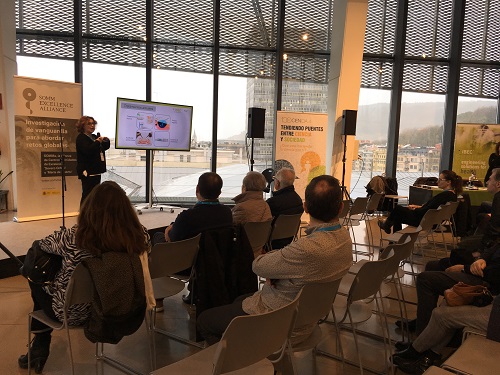
Elisabeth Engel en radio Euskadi
On the occasion of the annual meeting of the centres of excellence “Severo Ochoa and Maria de Maeztu” (SOMMa) at the 100xCiencia event, held in San Sebastián on November 22 and 23, Elisabeth Engel spoke on radio Euskadi about the intelligent devices they are developing in their laboratory. These bandages release nanoparticles containing calcium ions that are able to heal chronic lesions such as ulcers.
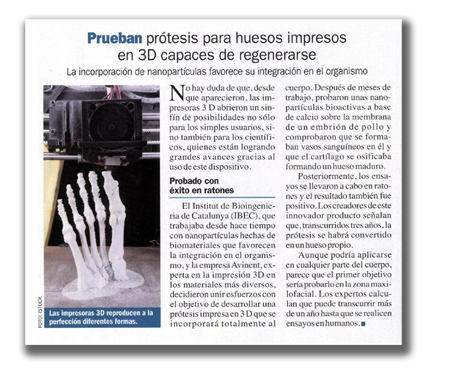
“Prueban prótesis para huesos impresos en 3D capaces de regenerarse”
Pronto magazine reported on IBEC’s 3D bioprinting capabilities and, in particular, the collaboration of the company AVINENT S.L. and the institute to carry out a research project to print personalized bone structures using 3D technology.

“Huesos de impresora que regeneran el propio”
Last week La Vanguardia reported on the collaboration of the company AVINENT S.L. and IBEC to carry out a research project to print personalized bone structures using 3D technology.
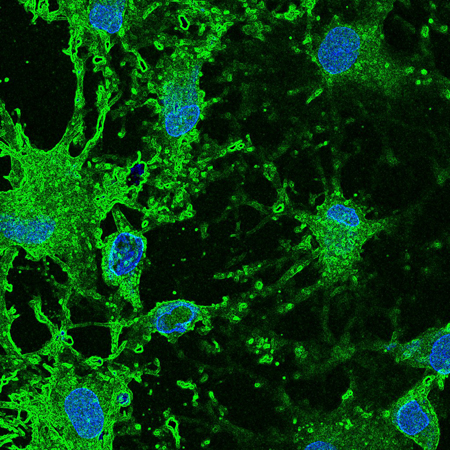
Biomaterials as signal-releasing platforms
IBEC’s Biomaterials for Regenerative Therapies group has published a review of the state-of-the-art in biomaterials for skin healing that proposes a move towards more personalized, in situ therapies. Skin wound healing repairs and restore tissue through a complex process that involves different cells and signalling molecules that regulate cellular response and the remodelling of the extracellular matrix. Publishing in Advanced Drug Delivery Reviews, the article begins by summarizing recent advances in therapies for healing that combine biomolecule signals such as growth factors and cytokines with cells.
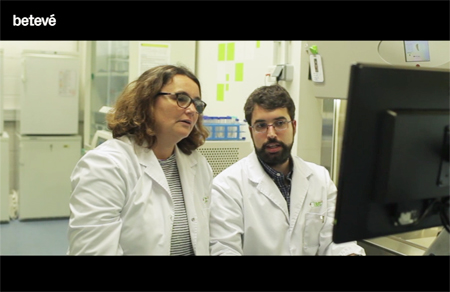
“Deuwatts: Enginyeria biomèdica”
Yesterday, in betevé’s “Deuwatts” programme devoted to biomedical engineering, they featured interviews with Elisabeth Engel and Sergi Rey.
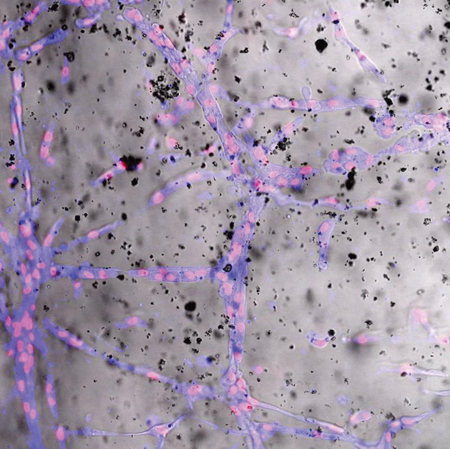
A material that encourages blood vessels to form
In a further step forward in their quest to achieve functional biomaterials for tissue regeneration, IBEC’s Biomaterials for Regenerative Therapies group has revealed a new construct that enhances blood vessel formation and maturation in vivo. In the paper published in Acta Biomaterialia at the end of last year, the group and their collaborators at the Georgia Institute of Technology present a new implantable hydrogel that contains both human mesenchymal stromal cells (hMSCs) and calcium-releasing microparticles.



 ibecbarcelona.eu
ibecbarcelona.eu